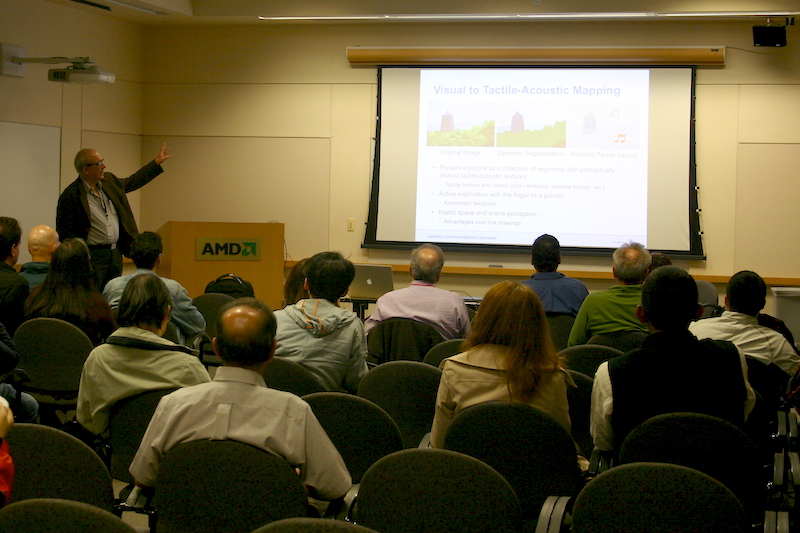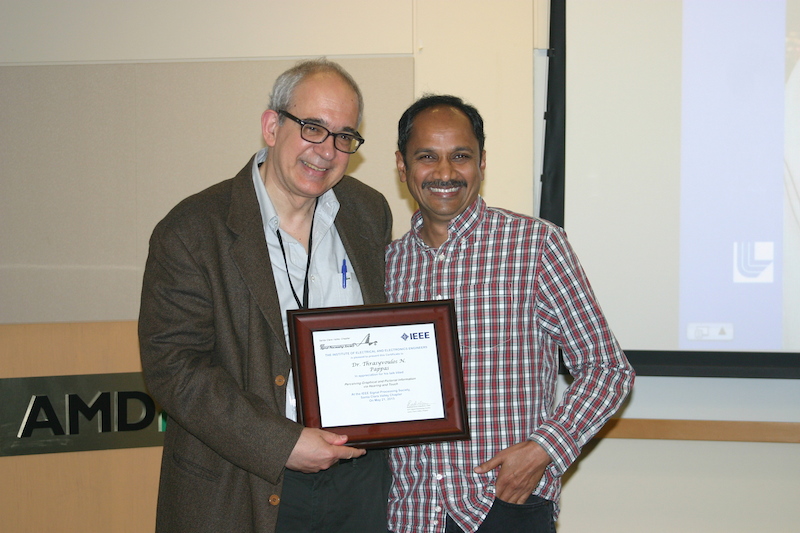|
|
Click here for see the full list of upcoming events.
Thursday, May 21, 2015
Perceiving Graphical and Pictorial Information via Hearing and Touch
This meeting is hosted/sponsored by IEEE SPS Chapter
Speaker :
Dr. Thrasyvoulos N. Pappas
Northwestern University, Evanston, Illinois
On Sabbatical Leave at Lawrence Livermore National Laboratory
Location:
AMD Commons C-3/4/5, 991 Stewart Dr., Sunnyvale, CA (map or Google Maps)
Schedule:
6:30pm: Networking/Light Dinner
7:00pm: Announcements
7:05pm: Presentation
8:15pm: Adjourn
Cost:
Free. Donation accepted for food.
Abstract:
We explore the use of hearing and touch for conveying graphical and pictorial information to visually impaired people. The main idea is that the user actively explores a two-dimensional layout consisting of one or more objects with the finger on a touch screen. The objects are displayed via sounds and raised-dot tactile patterns. The finger acts as a pointing device and provides kinesthetic feedback. The touch screen is partitioned into regions, each representing an element of a visual scene or graphical display, and each modality a different aspect of the layout. A key element of our research is the use of spatial sound to facilitate the active exploration of the layout. We use the head-related transfer function for rendering sound directionality and variations of sound intensity or tempo for rendering proximity. Our research has addressed object shape and size perception, as well as the perception of a 2-D layout of simple objects (dots). We have also considered the rendering of a simple scene layout consisting of objects in a linear arrangement, each with a distinct tapping sound, which we compare to a "virtual cane." Subjective experiments with visually-blocked subjects demonstrate the effectiveness of the proposed approaches.
Biography:
Thrasos Pappas received the Ph.D. degree in electrical engineering and computer science from MIT in 1987. From 1987 until 1999, he was a Member of the Technical Staff at Bell Laboratories, Murray Hill, NJ. He joined the EECS Department at Northwestern in 1999. He is currently on sabbatical leave at Lawrence Livermore National Laboratory (January to May 2015). His research interests are in human perception and electronic media, and in particular, image and video quality and compression, image and video analysis, content-based retrieval, model-based halftoning, and tactile and multimodal interfaces. Prof. Pappas is a Fellow of the IEEE and SPIE. He has served as editor-in-chief of the IEEE Transactions on Image Processing (2010-12), and technical program co-chair of ICIP-01 and ICIP-09. Prof. Pappas is currently serving as VP-Publications for the Signal Processing Society of IEEE. Since 1997 he has been co-chair of the SPIE/IS&T Conference on Human Vision and Electronic Imaging.
Talk Slides
Photos



* from-left: John Princen, Iole Moccagatta, Pavel Tcherniaev, Thrasyvoulos Pappas, Radhakrishna Giduthuri, Alex Acero
Subscribe to future announcements: link
|